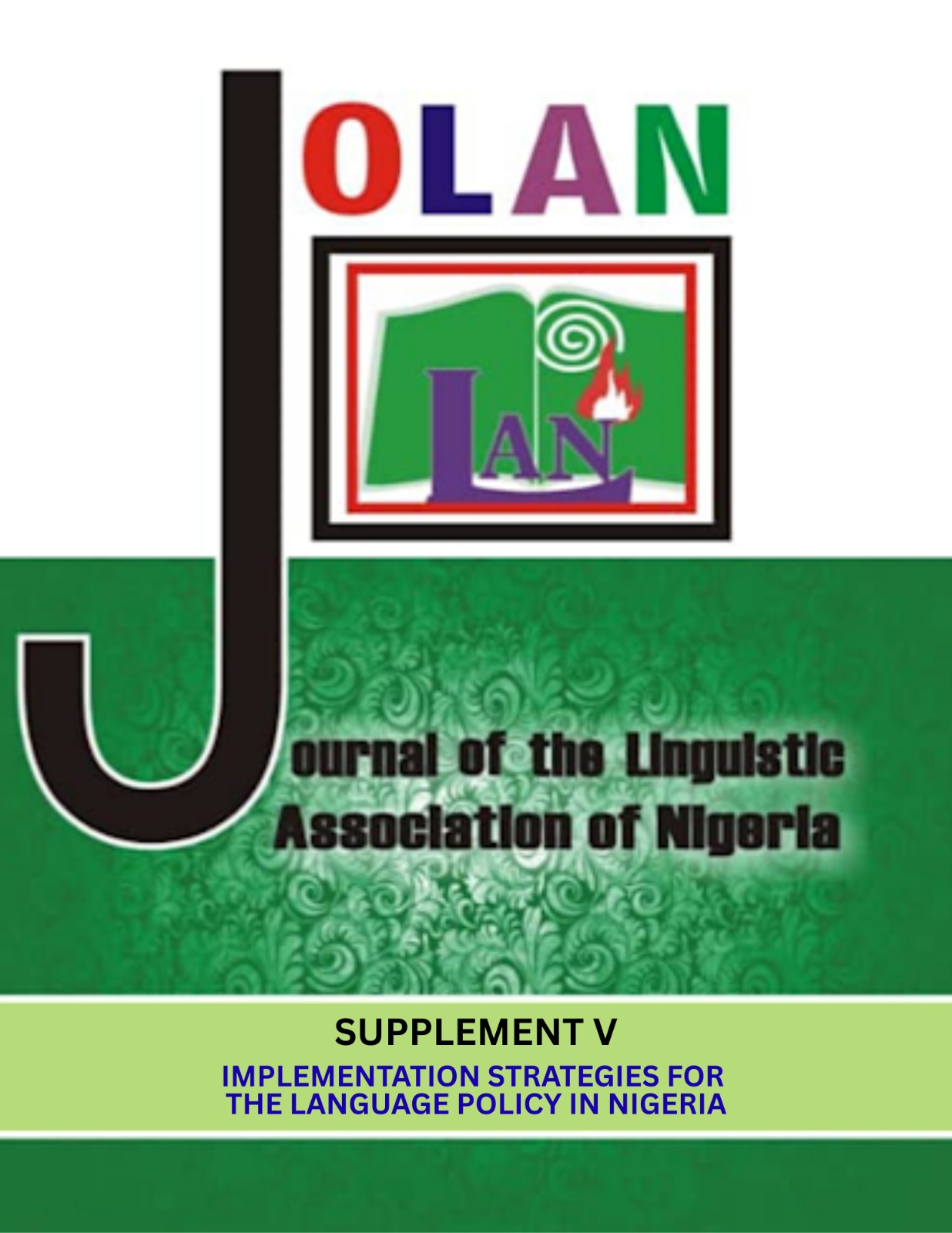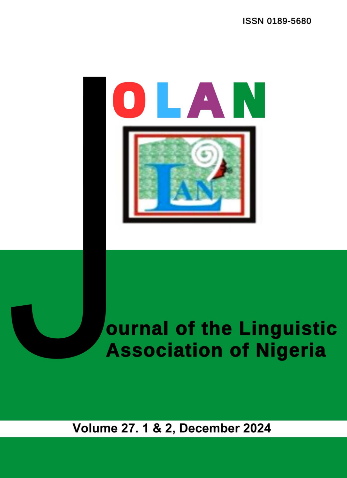Shigar giza-gizan kalmomin amsa-kama cikin rukunan nahawun Hausa
The integration of ideophonic words into Hausa grammatical categories
DOI:
https://doi.org/10.60787/jolan.vol5no1.423Keywords:
Amsa-kama, Nahawun Hausa, Giza-gizai, Rukunan Kalmomi, Ideophones, Hausa Grammar, Integration, Word ClassesAbstract
Tsakure
Wannan maƙala za ta yi na zarin shigar giza-gizan kalmomin amsa-kama cikin rukunan nahawu na Hausa. Amsa-kama na daga cikin kalmomin da ke bayyana sauti ko motsi ko yanayi ta hanyar kwaikwayo, kuma suna taka muhimmiyar rawa wajen ƙarfafa ma’ana a cikin jumloli. Manufar binciken ita ce gano yadda waxannan kalmomi ke samun matsayi a cikin rukunan nahawu da kuma rawar da suke taka wa wajen gina jumlolin Hausa.Binciken ya yi
amfani da dabarun nazarin jumloli da binciken nahawu don tantance matsayin amsakama.Wannan bincike ya dogara ne kan Ra’in Ginin Jumla na Chomsky 1957 (Generative Grammar) wanda ke da tsarin fahimtar dangantakar da ke tsakanin kalmomi a cikin jumla An tattara misalai daga rubuce-rubuce da tattaunawa da masu magana da Hausa don fahimtar yadda ake amfani da su a aikace. Sakamakon binciken ya nuna cewa amsa-kama na iya shiga
cikin rukunan nahawu daban-daban kamar su na da aiki da sifa da bayanau, dangane da yadda ake amfani da su a cikin jumloli.Wannan bincike zai bada gudummawa wajen fito da matsayin kalmomin amsa-kama a cikin rukunan nahawu tare da yadda amsa-kama ke daidaituwa da tsarin nahawu, wanda hakan zai tai maka ga ƙarin fahimtar tsarin Hausa da kuma bunƙasa nazarin harshen.
Abstract
This paper examines the integration of ideophones into Hausa grammatical categories. Ideophones are words that imitate sounds, movements, or conditions, and they play a crucial role in reinforcing meaning within sentences. The study seeks to identify how these words fit into grammatical categories and their functions in Hausa sentence construction. The research employs syntactic analysis and grammatical investigation to classify
ideophones. The theoretical foundation is drawn from Noam Chomsky’s Generative Grammar Theory (1957), which provides a framework for analyzing the structural relationships among words in sentences. Data were collected from written texts and discussions with native Hausa speakers to capture their practical usage. The findings reveal that ideophones can be integrated into different grammatical categories - such as nouns, verbs, adjectives, and adverbs - depending on their syntactic position. This study contributes to Hausa linguistics by highlighting the grammatical classification of ideophones and their alignment with the broader Hausa linguistic system. It not only enhances the understanding of Hausa grammar but also opens avenues for further research on the language.
References
Amfani, A. H. 1996. Aspects of agreement relations in Hausa clause structure. (Publisher not identified)
Abraham, R. C. 1960. The language of the Hausa people. University of London Press.
Baldi, S. 2013. Ideophones in Hausa. Dost-GottingerBeitragezursprachwissenschaft, 14, 1-21.
Bargery, G. P & Westermann, D. 1934. A Hausa-English Dictionary and English-Hausa Vocabulary. Oxford University Press.
Bagari, D. M., Leben, W. R. & McNair Knox, F. 1986. Manual of Hausa grammar. Ahmadu Bello University Press Limited
Bello, A. B. 2014. Sabon Nahawun Hausa. Ahmadu Bello University Press Limited.
Cole, D. T. 1995. An introduction to Tswana Grammar. London: Longmans, Green.
Galadanci, M. K. M. 1976. An introduction to Hausa grammar. Longman Nigeria.
Jinju, M. H. 1980. Rayayyen Nahawun Hausa. Northern Nigerian Publishing Company.
Newman, P. & Newman, R. M. 1977. Modern Hausa-English Dictionary. Oxford University Press.
Newman, P. 2000. The Hausa Language. An encyclopedic reference grammar. New Haven: Yale University Press.
Maduka, O. N. 1991. Phonosemantic rules and hierarchies: Evidence from roundness ideophones in Hausa. Afrikanistische Arbeitspapiere, 26, 167-175.
Pajak, A. 1989. Hausa ideophones: Language standard and practice. Hausa Studies II, 36-42.
Sambo, A. W. 2016. “Canonical Shape Analysis of Hausa and Bole Ideophones”. Doubleblind peer reviewed paper, doi:10.26478/ja2016.4.5.5
Thurston, H. P. 1886. “Onomatopoeia in Some West African Languages”. American journal of Philology.
Williams, W. R. 1970. “Syntax and meaning of Hausa ideophones: A new approach”. Unpublished Thesis. University of Wisconsin-Madison.
Yusuf, M. A. 2011. Hausa grammar: An introduction. Ahmadu Bello University Press Limited.
Downloads
Published
How to Cite
Issue
Section
License
Copyright (c) 2025 Journal of The Linguistic Association of Nigeria

This work is licensed under a Creative Commons Attribution-NonCommercial-ShareAlike 4.0 International License.














